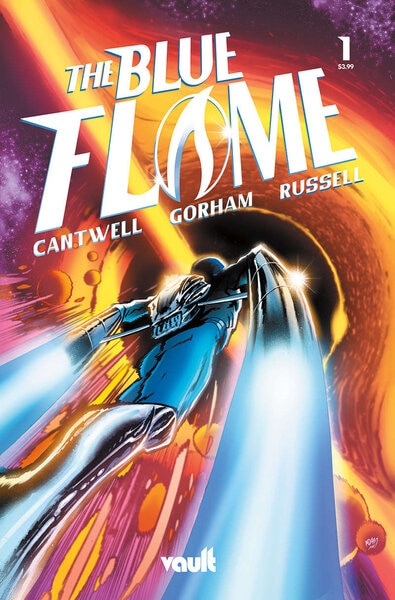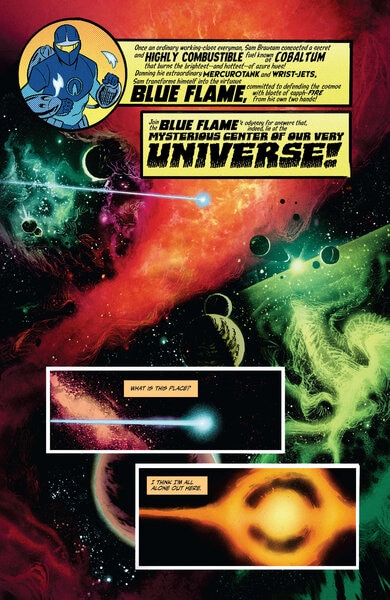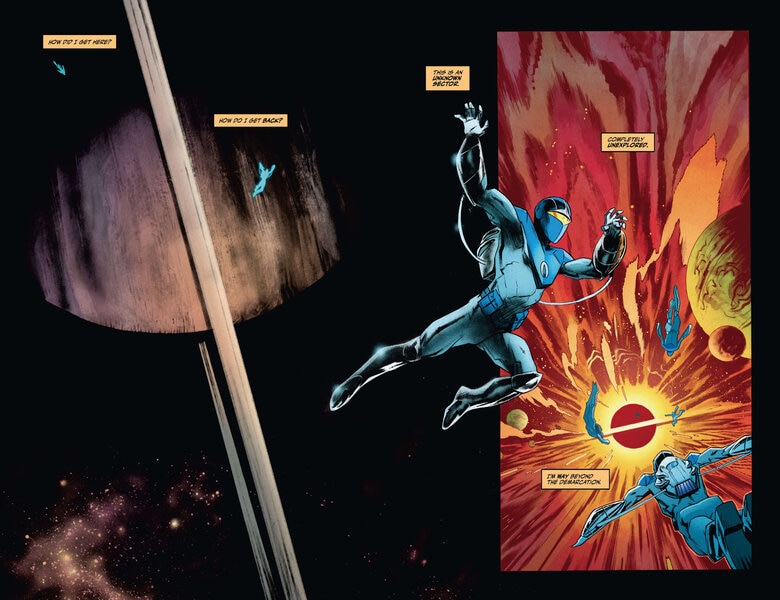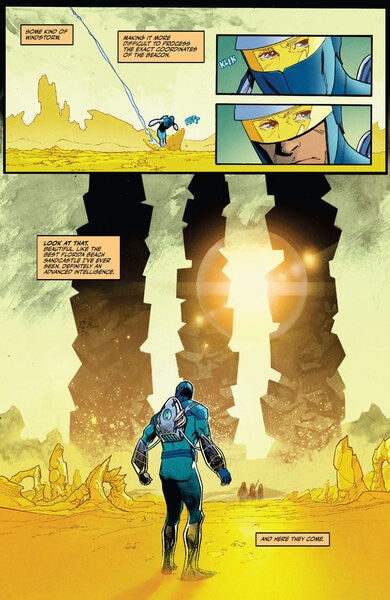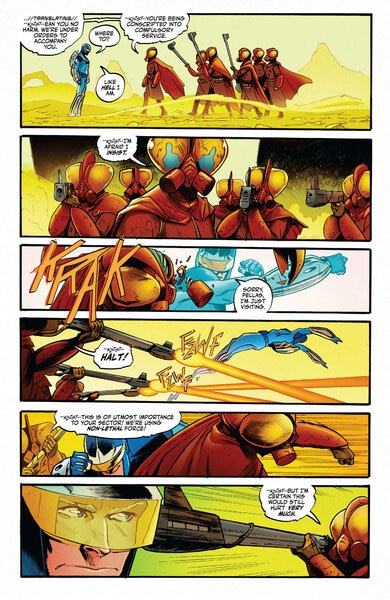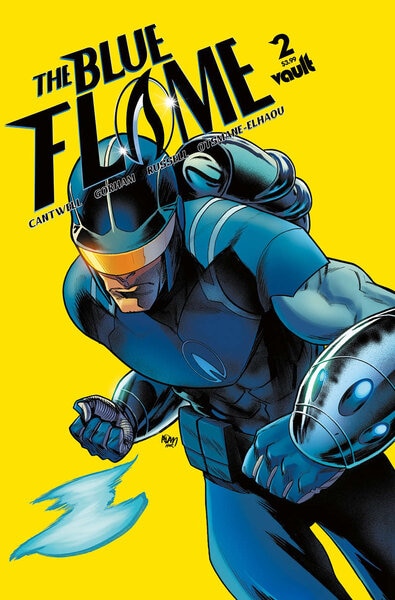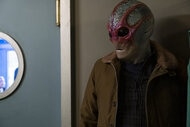Create a free profile to get unlimited access to exclusive videos, sweepstakes, and more!
Indie Comic Spotlight: The fate of the world rests in the mind of Blue Flame’s blue collar hero
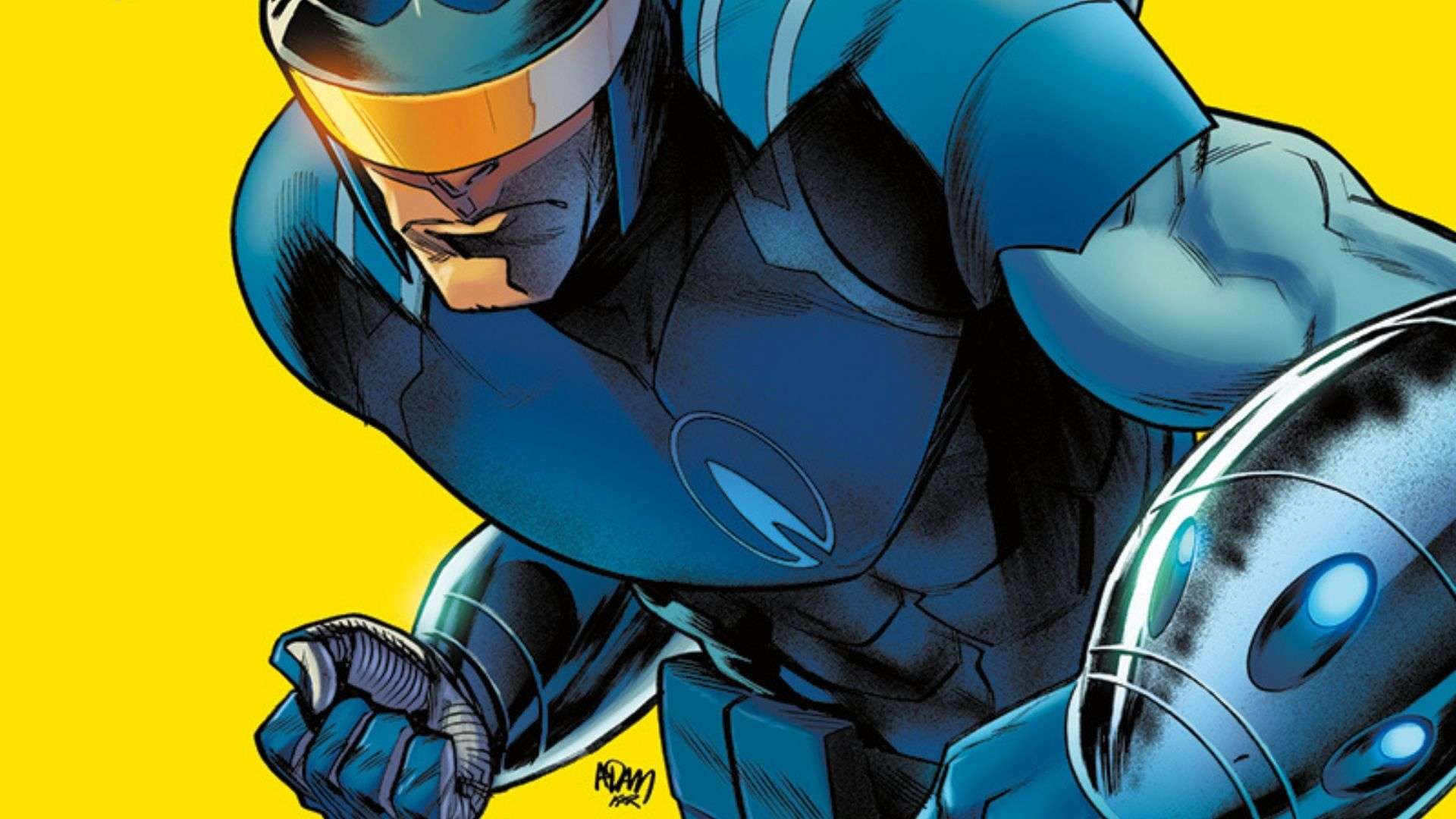
Vault Comics' new Blue Flame series from writer Christopher Cantwell (The United States of Captain America, Doctor Doom) and artist Adam Gorham (Punk Mambo, New Mutants) is nostalgic and eerily relevant at the same time. Colorist Kurt Michael Russell’s warm blue palette accentuated by Hassan Otsmane-Elhaou’s pulpy sci-fi lettering style gives the 10-issue series Rocketeer meets Strange Adventures vibes, while Cantwell’s time-jumping story feels like the modern Adam Strange take we've been waiting for.
The story unfolds in parallel storylines. In one, Sam Brausam, an HVAC repairman from Milwaukee, moonlights as the hero Blue Flame along with four other vigilante super buddies until tragedy strikes, leaving him badly injured. In the other, Sam lands on a distant planet only to be dragged before an intergalactic tribunal and tasked with proving Earth’s worthiness before it is wiped from the universe, Galactus-style. In both emotional plots, Sam must reconcile with the past to save the future.
It’s been five short years since Vault Comics launched in 2016. Since then, it has published thought-provoking, creator-owned work, including Savage Shores, Shadow Service, and Vagrant Queen. But Blue Flame is Vault’s first superhero offering. Or is it? Although the comic aligns with the publisher’s sci-fi, fantasy, and horror roots, it also manages to give us one of the most thought-provoking stories in comics all year.
Cantwell, best known for creating the hit series Halt and Catch Fire, masterfully reveals the ambidextrous narrative with the help of Russell’s subtle color shifts. And as of the fourth issue, we still don't know how the storylines correlate. Nevertheless, the creative team somehow managed to take the desperation and fear from one character and pull it in two different directions across two timelines, and mold a truly compelling superhero origin story out of it.
In an email interview with SYFY WIRE, both Cantwell and Gorham discuss "timey wimey" storylines, deconstructing superheroes, and how depression affects the people around us.
Did Vault come to you to create their first superhero series? Or was this a concept that you pitched them with?
Cantwell: I pitched the idea to Adrian Wassel at Vault after connecting with the company in the Fall of 2019. I’d been a huge fan of their titles and it thrilled me to get to work with them on something.
Gorham: I had established a good working relationship with Vault working on covers. When I was ready to take on interior work, Adrian reached out to me about a comic where a superhero is chosen to defend all of humanity in an intergalactic tribunal. It was a very novel concept, and after reading Chris’ script I was hooked.
What or who was the inspiration for this story?
Cantwell: The idea for this book came out of me doing my first work for Marvel and the elation that came with living a childhood dream by getting to write amazing superhero stories… but then trying to rectify that with the painful complexities of the reality we’re all living in. I asked myself, “Are superheroes still relevant?” The individualistic concept of a single hero fixing everything struck me as an impossible task, both for the world and for whomever might dare to take up that mantle. The story came from precisely that — a person trying to be a singular hero in modern American times, which to me posed the question of whether or not such a thing is even possible.
Blue Flame has that classic Adam Strange feel to it. Did you pitch that design? Or was that a directive?
Gorham: Chris had envisioned the essential elements of the character’s design. I looked at many things to find a version of the Blue Flame’s costume that felt right, and the majority of the team had input on certain aspects of my design. So much of this book has been a group effort and the costume is a fine example of that.
Does either version of Sam Brausam have superpowers?
Cantwell: I would say that even with the cosmic side of things, there are no “super” powers in this book. And yes there are bifurcated stories happening simultaneously here, each reflecting the other and informing the other… but it’s purposeful that neither story is either dispelled as a figment of Sam’s imagination, or nailed down as the one true narrative.
My easiest answer is: He’s both. Just like all of us are many things at once. That concept is just made more “comic book arch” here because of the abilities of the medium.
How did you approach switching between Sam's worlds? The transitions are seamless.
Gorham: My approach is similar to not walking through glass doors or tripping on the sidewalk: I try to be mindful of the surrounding environment. Chris' scripts are so vivid that imagining these starkly different environments is made easier for me, but in terms of the tools I use, I let shadows pool in the corners of environments or show the wear and tear on buildings and clothes, the fatigue in people's faces. I internalize all that and put it on the page.
Who are the Tribunal that have tasked Sam with defending the Earth from annihilation?
Cantwell: The Tribunal is made up of representatives of the Consensus, which itself is a galactic collective of highly advanced alien races spanning the galaxy and universe. The Tribunal determines what races are let into the Consensus, or if a race should be destroyed for being too dangerous or too threatening to the larger galactic stability and equilibrium.
What is the Tribunal’s reasoning for having Yarix, a victim of annihilation himself, be both Sam’s guide and prosecutor in the case?
Cantwell: I actually just finished writing Issue #7, and this is explored heavily between Yarix and Sam, and finally revealed, in that chapter. It’s purposeful that Yarix is guarded about it for much of the early part of the story. To me, a good harbinger character has to have suffered some kind of ultimate fate in the past in order to provide a sincere warning to the protagonist. That’s Yarix in our story. I know Adam drew inspiration from Death and Max von Sydow from The Seventh Seal when designing and drawing Yarix and Sam in their scenes together. That’s a pure stroke of genius that speaks exactly to what I wanted to convey with their dynamic.
Is this story a statement on society’s obsession with caped crusaders? Or is it a commentary on the state of the human condition?
Cantwell: There is some commentary on the idea of superheroes for sure. But to me the story is more about our individual agency, and our right and prerogative to try to change things and others around us. How much power do we have? How much power should we have? And even if we’re all the heroes of our own stories, are we really just bumping around for a few dozen years trying to make sense of things? And is maybe... that okay?
Gorham: [It’s also] that we don’t have to be defined by our worst day.
The lettering in this comic, more than others, is an integral part of the storytelling. What was your process with Hassan Otsmane-Elhaou?
Gorham: My process is to let Hassan do whatever he wants. The man has such a sharp sense of graphic story flow and a whole skill set that I don’t possess, there’s nothing I can really contribute to his already brilliant work.
Both your work on The United States of Captain America and Blue Flame shine a light on the “superhero everyman.” Why is that theme important to you right now?
Cantwell: We all fashion ourselves the brave adventuring heroes of our own lives. I think that can be empowering in a sense, and provide meaning and purpose. That’s the emphasis I’m placing on that idea in The United States of Captain America. But in Blue Flame, I also want to show how that idea can tip into self-centered suffering, both for the self and for others around a given person.
Will there be a second arc to this amazing series?
Cantwell: Nope, it’s a full 10 issues. It’s a complete story that ends at Issue #10. There’s no more story to tell after that.
